18.07 to 25.07.2009, 7 days, currency rate 1 € = 14,000 R (Rial)

 highlights – In Iran I was 10 years ago and till this moment it was my best visited country (along with Tonga). Best in the general category - but I think the biggest influence on my opinion have people openness. Now I went to see if Iran continues to deserve that opinion. Well, problems already began at the border - screams, fighting, disorder in the queue with their passports. But beginning doesn't mean much.
highlights – In Iran I was 10 years ago and till this moment it was my best visited country (along with Tonga). Best in the general category - but I think the biggest influence on my opinion have people openness. Now I went to see if Iran continues to deserve that opinion. Well, problems already began at the border - screams, fighting, disorder in the queue with their passports. But beginning doesn't mean much.
The Iranians have proved once again that they are one of the nicest people in the world. Although some shopkeepers and taxi drivers try to cheat tourists, the others make up the good impression. If you have a solitary nature and trying to avoid contact with people, Iran is not a place for you. Here, people come to you all the time just to say: "WELCOME TO IRAN," and sometimes it ends with a longer conversation. In 95% of cases they are not trying to sale anything.
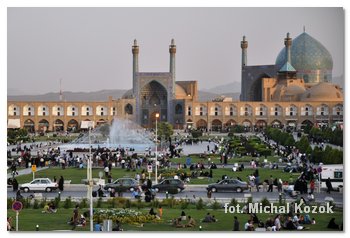 Isfahan's Imam Khomeini Square seems to be deserted in the mornings and afternoons. In the sun's heat only the beautiful minarets and decorated with green and blue mosques stand. In the evening the situation changes dramatically - blankets spread on the grass and whole family gather together with friends, they eat, play, discuss. There are a lot of people and when we were sitting down, someone immediately invited us to join them. Men greeted me, woman greeted Ewelina, followed by exchange of pleasantries, tea snacks, desserts, or sometimes a water pipe. Isfahan has wonderful mosques, bridges, squares, markets, etc, but the real city's atmosphere create locals. The great view of square we could see from the Qeysarieh tea house at the north end of the square.
Isfahan's Imam Khomeini Square seems to be deserted in the mornings and afternoons. In the sun's heat only the beautiful minarets and decorated with green and blue mosques stand. In the evening the situation changes dramatically - blankets spread on the grass and whole family gather together with friends, they eat, play, discuss. There are a lot of people and when we were sitting down, someone immediately invited us to join them. Men greeted me, woman greeted Ewelina, followed by exchange of pleasantries, tea snacks, desserts, or sometimes a water pipe. Isfahan has wonderful mosques, bridges, squares, markets, etc, but the real city's atmosphere create locals. The great view of square we could see from the Qeysarieh tea house at the north end of the square.
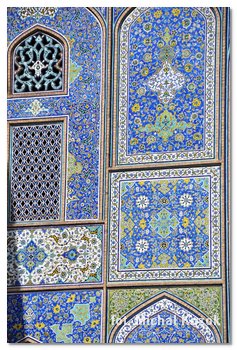 At least the main attractions are worth visiting. I wanted to see once again the most famous Imam Mosque. It again shocked me - its vastness, harmony, peace, millions of tiles composing fantastic designs. Near stands a small Sheikh Lotfollah Mosque. I didn't have such an impression as the Imam, but it also was curious. The next day we visited another part of town with Jameh Mosque (Friday Mosque), much older (XI century) than mosques on Imam Square. I could see that age - the different styles in different parts of the temple, mosaics were not well preserved, this largest Iranian mosque is simply but has a special atmosphere. The most we liked the halls with tons of columns.
At least the main attractions are worth visiting. I wanted to see once again the most famous Imam Mosque. It again shocked me - its vastness, harmony, peace, millions of tiles composing fantastic designs. Near stands a small Sheikh Lotfollah Mosque. I didn't have such an impression as the Imam, but it also was curious. The next day we visited another part of town with Jameh Mosque (Friday Mosque), much older (XI century) than mosques on Imam Square. I could see that age - the different styles in different parts of the temple, mosaics were not well preserved, this largest Iranian mosque is simply but has a special atmosphere. The most we liked the halls with tons of columns.
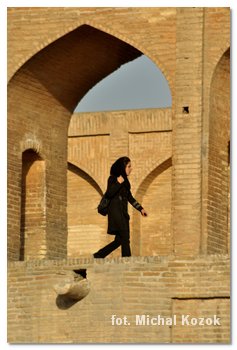 Of course you had to see Isfahan's fabulous bridges crossing the Zayandeh River. "Well, the bridge is nice, but where is this river?" - Evelina asked. Hmm, I really could cross the river bed with dry feet. So the evening atmosphere was not so wonderful – people still gathered, but not as many of them as in previous years, when the river was full of water. Just missing river sound and fresh breeze. Bridges are illuminated and two of them I liked particularly: Si-o-Seh and Khaju. As normal in Isfahan, we were invited by locals to the tea house under the bridge.
Of course you had to see Isfahan's fabulous bridges crossing the Zayandeh River. "Well, the bridge is nice, but where is this river?" - Evelina asked. Hmm, I really could cross the river bed with dry feet. So the evening atmosphere was not so wonderful – people still gathered, but not as many of them as in previous years, when the river was full of water. Just missing river sound and fresh breeze. Bridges are illuminated and two of them I liked particularly: Si-o-Seh and Khaju. As normal in Isfahan, we were invited by locals to the tea house under the bridge.
What else can you do in Isfahan? Roam the streets, those near and far from the center. Visit the markets, they are also unique. For “shaking minarets” (Manar Jomban) we didn't go because the other travellers complained about the fact that the minarets are not shaking any more. We walked a lot so we drank a lot - tap drinking water are at every step (I drank it without stomach problems, but if you have concerns about it, 1.5 liter bottled water costs just 3.000 R, 0.2 €), the delicious fresh fruit juices are often sell.
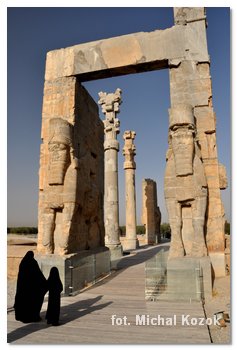 We arrived to Persepolis before the sunrise, so we slept on the benches next to the ticket office. When the first sun's rays began to illuminate the ruins, we went to admire them (the part you can see through the fence) in complete solitude. A few hours later we bought the tickets (now 0.2 €, but 10 years ago I paid 3.5 €). You can't take any kind of bag on site, but you can leave your backpacks in the storage room (3.000 R, 0.2 €). Nowdays little left after the palaces of Darius I (the Great), but the knowledge of the importance of the capital of Persia makes this place worth visiting. The deepest impression on us left Palace of 100 Columns and bas-reliefs staircase depicting notables carrying gifts to the Persian ruler. Before entering the museum (located in the ruins for additional charge) there is an interesting animation simulation on DVD, allowing to imagine how the Persepolis liked before the destruction. It is also worth to climb above the ruins to reach the rock tombs of Artaxerxes II and III. If you like show "light and sound" you have a chance to see it here. Just outside the ruins are the remains of the great banquet which was hold in 1971 and host by the last Shah of Iran, Mohammad Reza Pahlavi (fantastically described in Ryszard Kapuscinski book “Shah of Shahs”).
We arrived to Persepolis before the sunrise, so we slept on the benches next to the ticket office. When the first sun's rays began to illuminate the ruins, we went to admire them (the part you can see through the fence) in complete solitude. A few hours later we bought the tickets (now 0.2 €, but 10 years ago I paid 3.5 €). You can't take any kind of bag on site, but you can leave your backpacks in the storage room (3.000 R, 0.2 €). Nowdays little left after the palaces of Darius I (the Great), but the knowledge of the importance of the capital of Persia makes this place worth visiting. The deepest impression on us left Palace of 100 Columns and bas-reliefs staircase depicting notables carrying gifts to the Persian ruler. Before entering the museum (located in the ruins for additional charge) there is an interesting animation simulation on DVD, allowing to imagine how the Persepolis liked before the destruction. It is also worth to climb above the ruins to reach the rock tombs of Artaxerxes II and III. If you like show "light and sound" you have a chance to see it here. Just outside the ruins are the remains of the great banquet which was hold in 1971 and host by the last Shah of Iran, Mohammad Reza Pahlavi (fantastically described in Ryszard Kapuscinski book “Shah of Shahs”).
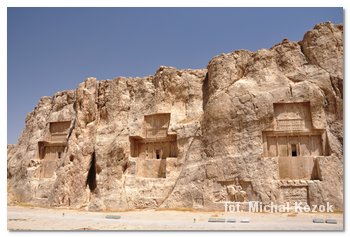 About 6 km away there are Naqsh-e Rostam rock tombs. We were walking there from Persepolis, but after a short time one driver gave us a lift (we even didn't try to hitchhike). This is a very interesting place - in the middle of cliff rock people dug four royal tombs for Darius I and II, Xerxes I and Artaxerxes I. You can't enter inside the tomb because the entrance is carved high in middle of vertical rock. It looks impressive. Zartosht Kaba is located opposite the tombs and it was probably a fire temple, treasury or calendar.
About 6 km away there are Naqsh-e Rostam rock tombs. We were walking there from Persepolis, but after a short time one driver gave us a lift (we even didn't try to hitchhike). This is a very interesting place - in the middle of cliff rock people dug four royal tombs for Darius I and II, Xerxes I and Artaxerxes I. You can't enter inside the tomb because the entrance is carved high in middle of vertical rock. It looks impressive. Zartosht Kaba is located opposite the tombs and it was probably a fire temple, treasury or calendar.
Kerman did not specially charmed us. In the center of the town we visited the bath museum (hamman), but it was just to kill the time. At afternoon we had an appointment with the Jalal Guesthouse owner (phone from LP: 271 0185 or 0913 142 3174, accommodation in the hostel costs 20 $ per person). He promised us the desert trip: including English-speaking driver and air-conditioned jeep. Unfortunately there was only Farsi speaking driver and old warm car. Day trip cost 60 $ for two people, and you can decided to stay at driver's home for additional 5 $ pp. 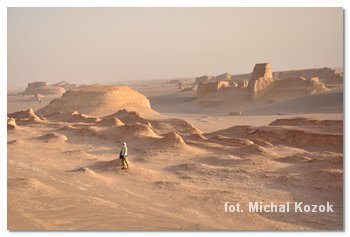 We had no enough time and decided for just an half-day trip. We started in Jalal Guesthouse at 2pm and we drove to one of the hottest places on earth – Ka-Lut Desert. But before we got there from Kerman, Iranian's driver took us to his home in Shahdad for refreshments. He showed the deserted medieval caravanserai and a huge reservoir (looks like a tower). When the temperature has dropped considerably we went to the sands. For me that was one of the most beautiful places in the world in rough terrain category. Over the centuries nature carved here amazing rock towers and castles. At sunset when the heat was still close to 50 º C and the wind carrying hot sand, we walked between the rocks and enjoyed the beauty of our planet. Due to lack of time (Turkmen visa) we could not sleep here in tent – but it would be the perfect place. If I had another chance, I would go from Kerman to Shahdad by public transport, and there ask around for a lift to "sand castles"(approximately 15 km), extending over several kilometers along the paved road. We have seen the trucks as well, so I think that even hitchhiking can works there.
We had no enough time and decided for just an half-day trip. We started in Jalal Guesthouse at 2pm and we drove to one of the hottest places on earth – Ka-Lut Desert. But before we got there from Kerman, Iranian's driver took us to his home in Shahdad for refreshments. He showed the deserted medieval caravanserai and a huge reservoir (looks like a tower). When the temperature has dropped considerably we went to the sands. For me that was one of the most beautiful places in the world in rough terrain category. Over the centuries nature carved here amazing rock towers and castles. At sunset when the heat was still close to 50 º C and the wind carrying hot sand, we walked between the rocks and enjoyed the beauty of our planet. Due to lack of time (Turkmen visa) we could not sleep here in tent – but it would be the perfect place. If I had another chance, I would go from Kerman to Shahdad by public transport, and there ask around for a lift to "sand castles"(approximately 15 km), extending over several kilometers along the paved road. We have seen the trucks as well, so I think that even hitchhiking can works there.
We got lost many times in Yazd old town narrow streets. It is a labyrinth. Interesting, but I expected something more. Note the clay towers located on the house's roof - they are designed to catch the wind and direct it inside to the apartment in order to cool it down. 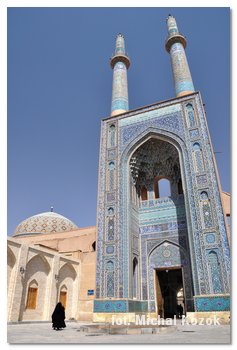 Well, such a healthy air-conditioning. Within the old town there are many museums and places to comment. We liked the Jameh Mosque and the nearby Bogheh-ye Sayyed Roknaddin (between them it is Silk Road Hotel with not cheap but tasty Indian food). Amir Facade Chakhmaq look good from the ground level, but climbing it up allowed for the city view. Next to it the Water Museum is located, and there is interestingly presented system of underground irrigation channels which supplied homes with drinking water. A large water tank (reservoir) can be seen in the northern part of the old town - there is a place to be lost in clay winding streets.
Well, such a healthy air-conditioning. Within the old town there are many museums and places to comment. We liked the Jameh Mosque and the nearby Bogheh-ye Sayyed Roknaddin (between them it is Silk Road Hotel with not cheap but tasty Indian food). Amir Facade Chakhmaq look good from the ground level, but climbing it up allowed for the city view. Next to it the Water Museum is located, and there is interestingly presented system of underground irrigation channels which supplied homes with drinking water. A large water tank (reservoir) can be seen in the northern part of the old town - there is a place to be lost in clay winding streets.
At afternoon we went to see the Zoroastrians sight (the main religion of the region before the Arabs brought the Islam). For Zoroastrians followers the fire is a holy thing - they have temples where the sacred flame is held continuously for centuries (that is why you shouldn't have any water with you). One of their custom also says to not bury or burn the bodies (soil and air pollution). Over the centuries they exhibited the dead bodies to be eaten by vultures. For this purpose they built "Towers of Silence" - round no-roof towers on the top hill, so that vultures could clear the bones in peace. We went to see Dakhmeh-ye Zartoshtiyun – from Beheshti roundabout (at the entrance to the Yazd old town) we caught a bus /minibus to Abuzari roundabout, where we took another public transport south-west direction to the first roundabout. Hence the remaining 2 km we walked further in the same direction. The ticket office was closed during the afternoon siesta, but we could get around the fence and entered into the site without a ticket - no one asked.
In the holy Shiites city, Mashgad, we admired the immense of Haram-e Razavi Holy Shrine, with more than 10 million pilgrims annually. The site has religious atmosphere. Inside you can not take any bags or even cameras – in front of the main entrance is free luggage storage. Non-Muslims must not enter there alone - the guard called for English-speaking guide. He brought the chador for Ewelina - a compulsory part of female attire. After the personal checks we were inside this amazing complex. Navigating with the guide is a very comfortable option in this free tour - you know where you can go, so you don't have to worry you accidentally might offend the Muslims.  Guide instructed us to the customs, explained the importance of individual elements and historical topics. We couldn't enter the most sacred places, but we were satisfied what we have seen in this complex. Anyway, the most important is the atmosphere.
Guide instructed us to the customs, explained the importance of individual elements and historical topics. We couldn't enter the most sacred places, but we were satisfied what we have seen in this complex. Anyway, the most important is the atmosphere.
During our visit a pleasant Iranian attitude accompanied us. Hardly anyone speaks English, but help was offering everywhere, or simply you we were greeted with a smile. They are so nice that still after visiting 122 countries the people of Iran (and Tonga) deserve the highest notes. Normally in July and August due to high temperatures (at night over 30°C) there are not many tourists, and especially after the last presidential elections and the subsequent demonstrations.
For Ewelina it wasn't so easy – she had to wear long sleeves and cover hair in a chador, sit in a separate sector in the urban buses, men often ignored her - this is a local culture. In addition you shouldn't show emotions like kissing or a hugging in the public, and we were on honeymoon trip. Well, I do not complain, because I am happy that I can recommend Iran as different, exotic, safe and friendly for tourists country.
| town | site | price in R | €/ per | duration | note | comments |
| Esfahan | Imam Mosque | 5,000 R | €0.4 | 1 h | worth | |
| Sheikh Lotfollah Mosque | 4,000 R | €0.3 | 15' | ok | ||
| Jameh Mosque | - | - | 1 h | ok | ticket office closed on Friday | |
| Persepolis | ruins | stud. 3,000 R | €0.2 | 2 h | worth | normal 5,000 R |
| Naqsh-e Rostam | rock tombs | 5,000 R | €0.4 | 45' | worth | no student discount |
| Kerman | baths museum (hammam) | stud. 2,500 R | €0.2 | 30' | no good | normal 5,000 R |
| Ka-Lut Desert | 60 $/ 2 per | €21.0 | half day | super | ||
| Yazd | Amir Chakhmaq | stud. 1,500 R | €0.1 | 30' | no good | get upstairs, normal 3,000 R |
| water museum | - | - | 30' | ok | ||
| Khan-e Lari | 2,000 R | €0.1 | 30' | no good | no student discount | |
| towers of silence | - | - | 1 h | ok | ticket office closed in afternoons | |
| Mashgad | Imam Reza Holy Shrine | - | - | 2 h | worth | with English speaking guide |
| €23 |
![]()
accommodation – In Isfahan I slept in the same hostel as in 1999. Amir Kabir Hotel (Chahar Bagh Abbasi Street) didn't impressed me so much this time. “Thanks” to the owners – they didn't really do anything wrong, but they were like machines, no sense of humor and talk only about money. If I omitted this fact, the hostel is pretty decent - clean dormitories for 60.000 R (4.3 €), hot showers, laundry, internet, free luggage storage, the possibility to buy breakfast (not worth the price).
The remaining 5 nights in Iran we spent in comfortable buses, but once we arrived to Yazd at 3 am - so we spread our mats and sleeping bags in the middle of roundabout. Last night we spent in the tent on Turkmenistan border.
![]()
transport – getting inside the bus station you can chose from a full range of coaches leaving at different times. All prices are the same when it comes to the same coach class. There are two classes: one is called "Volvo" (luxurious, but it doesn't mean that only buses made by Volvo company operate it), and the cheaper second one is called "Mercedes" (old models). The difference in coach class consists: air conditioning, the width and the distance between seats, duration of travel, in Volvo you get a snacks, in Mercedes you will have to listen to loud music. The biggest difference is the fare - Volvo is 3 times more expensive than Mercedes - for every 100 km you pay roughly 0.9 € instead of 0.3 €. Unfortunately often I could not find the cheaper companies. You can buy a ticket a few days in advance.
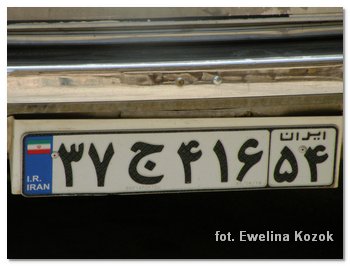 Coming to Persepolis from Isfahan we decided to cut a journey time. We paid 10,000 R less than ticket to Shiraz, but we got off in Marvdasht, the nearest village to Persepolis. However it was a mistake, because from Marvdasht it's too far to walk - 5 km to the town center, and then another 13 km to the Persepolis. So in the middle of the night we had to catch not the cheapest ride. I suggest to tell Ifahan-Shiraz bus driver that we want to get off at Naqsh-e Rostam highway exit (several kilometers before the Marvdasht exit). From this intersection is just 15-20 minutes walk to rock tombs in Naqsh-e Rostam, where we can wait until morning. After visiting the tombs we can back to the intersection and continue the march to the Persepolis. These two fantastic attractions are just 6 km apart.
Coming to Persepolis from Isfahan we decided to cut a journey time. We paid 10,000 R less than ticket to Shiraz, but we got off in Marvdasht, the nearest village to Persepolis. However it was a mistake, because from Marvdasht it's too far to walk - 5 km to the town center, and then another 13 km to the Persepolis. So in the middle of the night we had to catch not the cheapest ride. I suggest to tell Ifahan-Shiraz bus driver that we want to get off at Naqsh-e Rostam highway exit (several kilometers before the Marvdasht exit). From this intersection is just 15-20 minutes walk to rock tombs in Naqsh-e Rostam, where we can wait until morning. After visiting the tombs we can back to the intersection and continue the march to the Persepolis. These two fantastic attractions are just 6 km apart.
From Quchan to the border in Bajgiran it's hard to find a public transport. You can bargain a taxi for 80.000 R (5.7 €).
City buses are very cheap - for example in Isfahan from the bus terminal to the city center (over 20 min ride) you are paying 400 R (0.03 €).
| day | destination | transport | price in R | €/ per | duration | km |
| 10-11 | Baku (Azerbaijan) - Teheran | Volvo night bus | data in Azerbaijan | 22 h | Azerb. 323 Iran 500 | |
| 11-12 | Teheran - Esfahan | Volvo night bus | 55,000 R | €3.9 | 6.5 h | 440 |
| 13-14 | Esfahan - Marvdasht | Volvo night bus | 45,000 R | €3.2 | 6.5 h | 440 |
| 14 | Marvdasht - Persepolis | walk + taxi | 30,000 R/ 2per | €1.1 | 50' + 15' | 4 + 14 |
| 14 | Persepolis - Naqsh-e Rostam | walk + hitchhiking | - | - | 50' + 5' | 4 + 2 |
| 14 | Naqsh-e Rostam - Shiraz | hitchhiking | - | - | 45' | 57 |
| 14-15 | Shiraz - Kerman | Mercedes night bus | 23,000 R | €1.6 | 9.5 h | 570 |
| 15 | Kerman - Ka-Lut + return | car | data in highlights | hlaf day | 2x 170 | |
| 15-16 | Kerman - Yazd | Volvo night bus | 45,000 R | €3.2 | 5 h | 360 |
| 16-17 | Yazd - Mashgat | Volvo night bus | 120,000 R | €8.6 | 13.5 h | 920 |
| 17 | Mashgat - Quchan | Mercedes bus | 8,000 R | €0.6 | 2.5 h | 134 |
| 17 | Quchan - Bajgiran | 2x hitchhiking | - | - | 1.5 h | 80 |
| city transport | taxi, bus | 9,500 R/ per | €0.7 | - | - | |
| €23 | 3865 | |||||
![]()
visa – first you must apply for “visa permission”. I printed an application form from the internet, attached a photograph, passport photocopy and sent the documents to embassy by post. After nearly two weeks I called to Warsaw for a confirmation - “the permission” was granted. Then I had to make a 60 € payment (plus banking commission) - the next day I received my visa.
Iran has embassies in all countries visited by us during this trip.